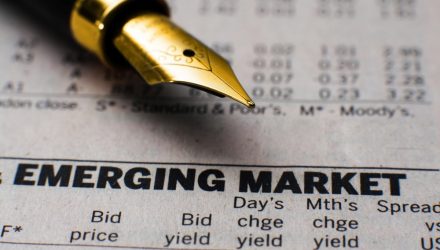An exodus from emerging markets (EM) assets has been taking place thanks to a combination of the coronavirus outbreak and falling oil prices. Investors are opting to park their capital into safer havens, which puts EM companies at risk of default.
This was readily apparent in rising yields on EM debt as the countries in the most tenuous positions headed toward distressed levels. For example, a Wall Street Journal report noted that the “dollar-denominated Angolan government bond maturing in November 2025 jumped to nearly 30% on Friday, from under 7% at the beginning of March. And the yield on a comparable Nigerian bond maturing in June 2022 has jumped to almost 12% from 4%.”
Angola is just one of 18 countries that are seeing their government debt yields at 10 points above that for U.S. Treasury notes, based on data from Capital Research. In this low yield environment, it’s an option for fixed income investors, but the risk could be too much to accept.
“The chances of a wave of sovereign defaults is the highest it’s ever been,” said Edward Glossop, emerging markets economist at Capital Economics.
The skyrocketing yield makes itself apparent in the High Yield Emerging Markets Corporate Plus Sub-Index Effective Yield chart below:
High Yield Emerging Markets Corporate Plus Sub-Index Effective Yield data by YCharts
As opposed to playing the weakness of emerging markets directly via shorting or inverse funds, traders can use the Direxion MSCI Developed Over Emerging Markets ETF (NYSEArca: RWDE). RWDE provides a means to not only see developed markets perform well, but a way to access a convergence/catch-up in performance of DM relative to EM, a spread that has clearly widened over the past 6 months. The fund seeks investment results, before fees and expenses, that track the MSCI EAFE IMI – Emerging Markets IMI 150/50 Return Spread Index.
The index measures the performance of a portfolio that has 150% long exposure to the MSCI EAFE IMI Index (the “Long Component”) and 50% short exposure to the MSCI Emerging Markets IMI Index (the “Short Component”).On a monthly basis, the Index will rebalance such that the weight of the Long Component is equal to 150% and the weight of the Short Component is equal to 50% of the Index value. In tracking the Index, the Fund seeks to provide a vehicle for investors looking to efficiently express a developed over emerging investment view by overweighting exposure to the Long Component and shorting exposure to the Short Component.
If traders sense that EM assets present a value option over developed markets, there’s the Direxion MSCI Emerging Over Developed Markets ETF (NYSEArca: RWED) offers them the ability to benefit not only from emerging markets potentially performing well but from emerging markets outperforming developed markets.
RWED seeks investment results that track the MSCI Emerging Markets IMI – EAFE IMI 150/50 Return Spread Index. The Index measures the performance of a portfolio that has 150 percent long exposure to the MSCI Emerging Markets IMI Index and 50 percent short exposure to the MSCI EAFE IMI Index.
For more relative market trends, visit our Relative Value Channel.


